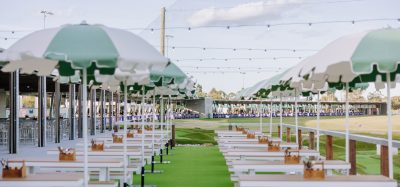Integrating local culture into airport design
Posted: 2 July 2025 | Gabriel Higgins | No comments yet
Airports worldwide are weaving local culture into their architecture, design, and retail, offering passengers a deeper sense of place from arrival to departure through immersive, regionally inspired experiences. International Airport Review Assistant Editor, Gabriel Higgins explores a few key airports in detail.


Credit: Hyderabad International Airport
To experience another culture has always been a driving force behind why people travel. For most travellers, this journey begins and ends with the airport. An airport can be the first experience of a new land, people, cuisine and culture. Or it can be the last chance to experience what their travels had to offer before they return to the mundane.
For airports, integrating the local culture into their design is an opportunity to leave a mark on their passengers. From architecture that reflects the natural woodland habitat of North America, to the Bavarian beer halls of Germany, we take a closer look at airports around the world that have incorporated local culture.
Portland International Airport (PDX), USA
Situated in the Pacific Northwest of America, Portland Airport serves the state of Oregon as its busiest airport. Oregon’s most profound natural scenery is its dense forests, covering almost half the state.
Join us live: Shaping the Next Generation of Hold Baggage and Air Cargo Screening
Join us live for an insightful webinar on 11th December at 14:00 GMT, in collaboration with Smiths Detection, as we explore the strategic balance of operational efficiency, regulatory compliance, and sustainability in high-volume security environments.
This session offers a focused look into future-proofing your security strategy.
Key learning points
- Cost Reduction: Strategies to minimize bag travel time while simultaneously reducing operational costs.
- Regulatory Roadmap: Insights into the next wave of regulatory changes and their impact on future investment decisions.
- Sustainable Systems: Practical approaches to building sustainability into security systems and lowering the total cost of ownership (TCO).
- Scalable Solutions: Real-world examples of scalable systems supporting current airport growth and preparing for tomorrow.
Register now for expert insights, case studies, and actionable strategies on operational efficiency!
Portland Airport reflects the importance of the region’s forests in the architectural design of its terminal. Designed almost entirely with wood to give travellers a sense of place and evoke a sense of relaxation and wellbeing, it draws inspiration from the airport’s backyard, invoking a walk in the forest.
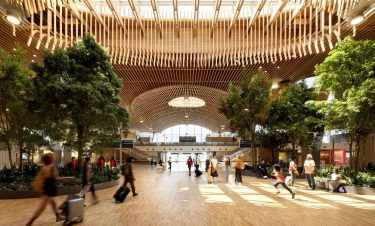

Credit: Portland International Airport (PDX).
As the airport explains: “Wood is such a rich part of our regional history and landscape, and when travellers arrive at PDX, they’ll know exactly where they are.”
The airport set out to source as much of the wood for the new PDX as possible in a way that creates better outcomes for the regional forests and the people who manage them. Sourcing local wood kept the money in the region and provided more opportunities for small businesses.
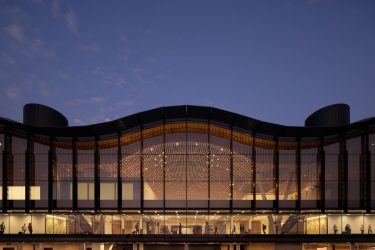

Credit: Portland International Airport (PDX).
“And, by tracing as much as possible and committing to sustainable sourcing, we know it was harvested in a way that helps make our forests stronger.”
The dense forest and woodlands of the region aren’t the only important features for the local culture. The airport’s terminal was home to an iconic carpet designed in the 1980s.
The heavily travelled (and photographed) PDX carpet has become a local staple in the community. As the ‘front door’ to the city for those arriving by air, PDX is often a traveller’s first impression of Oregon, and it reminds residents that they are home.
When it was announced in 2015 that the teal icon would be replaced as part of the airport redevelopment, it became clear that the community didn’t want to say goodbye.
“So, we worked closely with a U.S. carpet manufacturer to replicate the original abstract pattern, which was locally designed in 1987 and inspired by what an air traffic controller sees from the tower at night: runways, intersections and lights,” explained the airport.
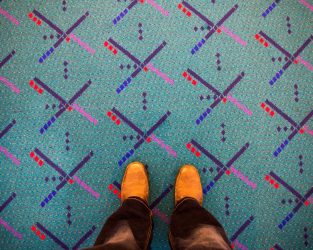

The iconic carpet will be found in places where you’re likely to wait or sit, while high traffic areas will have terrazzo and Oregon White Oak flooring.
PDX noted that: “Travellers were very understanding about replacing the carpet with a smoother surface that’s easier for wheelchairs and roller bags to navigate, but certainly appreciate that their backdrop for shoe selfies will remain in the fabric of PDX.”
Nature and design are cornerstones of the design of the terminal, but they are also important to the revenue of the airport. Again, PDX represent what the city has to offer. PDX explains why they have selected certain brands:
“Local brands have always been a cornerstone of our programme at PDX. With the new PDX, we want travellers to know exactly where they have landed, before even leaving the airport. A big part of creating that sense of place is the shops and restaurants inside, and for these to be a true reflection of our community. It not only gives travellers a taste of our region but also creates opportunities for small businesses that we know and love.”
The 22 new concessions are 100% local brands, and nearly 50% have women or BIPOC ownership, well above the 11% average for airport concessions.
Zurich Airport (ZRH), Switzerland
Located in the foothills of the Alps, Zurich Airport, like Portland Airport, desires to reflect the region’s traditional timber industry. Flughafen Zürich AG has delivered the winning project for the construction of the new Dock A with tower and dock base as part of a project tender. It will be built largely of wood and will set new standards in terms of sustainable terminal buildings. The new Dock A will be constructed over the next 10 years.
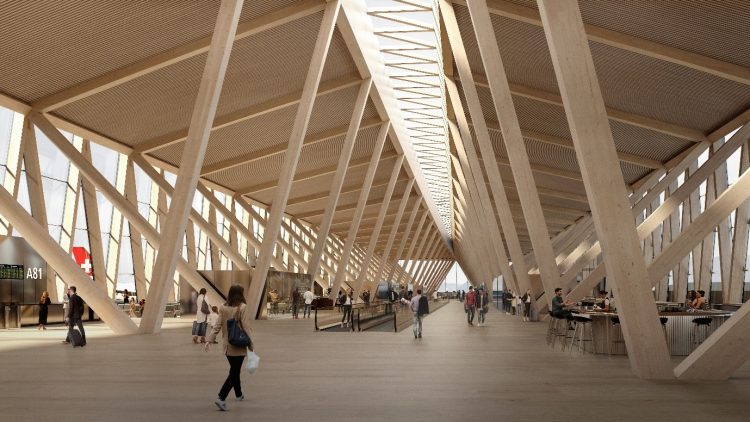

Credit: Flughafen Zürich AG
The visible timber truss (Raumfachwerk) is a defining architectural element of Dock A, evoking Switzerland’s deep-rooted tradition of timber construction.
Zurich Airport stated that: “It combines structural clarity with a rhythmic, open spatial experience. The expressive use of wood and the reference to Swiss building typologies give the terminal a strong Swiss identity.”
The timber structure not only recalls historical Swiss craftsmanship, but also demonstrates contemporary engineering excellence.
Zurich explains how the balance is struck between innovation and tradition in this timber terminal:
“Dock A merges contemporary structural innovation with elements of Swiss architectural tradition. The timber trusses express a modern engineering approach, while the use of natural materials and modular design reflects traditional Swiss values of craftsmanship and clarity. It is a thoughtful integration of the old and the new.”
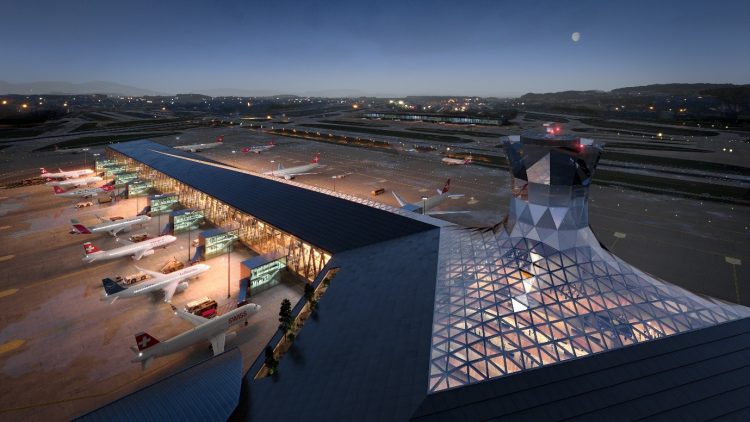

Credit: Flughafen Zürich AG
Sustainability is also central to the project: the hybrid construction system (timber and concrete) and prefabrication all aim to reduce resource consumption and carbon emissions. A key feature is the extensive photovoltaic system on the Dock’s roof, which is designed to generate two-thirds of the terminal’s electricity consumption.
These strategies directly support the project’s target of achieving LEED Gold certification, reflecting high standards in energy efficiency, material selection and overall ecological performance.
Munich International Airport (MUC)
Munich Airport is based in the heart of Bavaria, a traditional medieval state in Germany, and boasts its rich history and brewing abilities of some of the best beer in the world.
The airport showcases Bavarian culture with traditional architecture, beer gardens and events like live music performances and beer festivals, offering travellers a taste of local traditions.
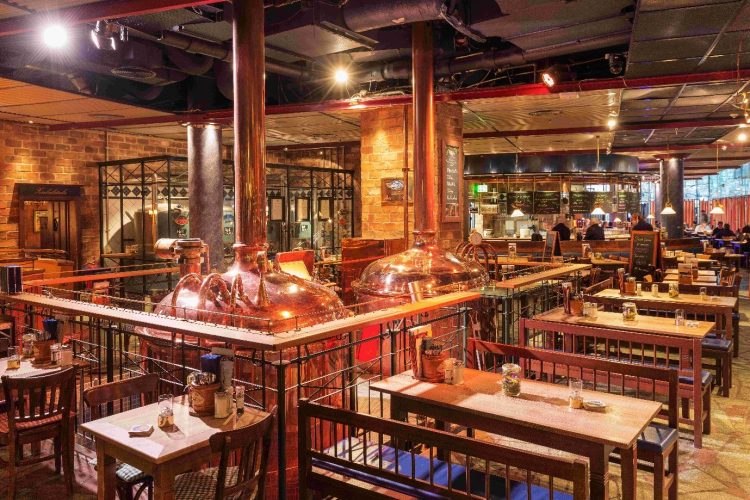

Credit: Munich Airport
Munich Airport CEO, Jost Hammers, explains the unique beer that is crafted in the airport:
“Being part of Bavaria, it’s part of our history and tradition. We have our own beer crafted within the airport, by Airbräu brewery, open all year round for passengers to enjoy.”
The airport even celebrates Oktoberfest for passengers to enjoy, which begins in May. For passengers, this is the gateway to Bavaria.
Munich Airport also explain how beer gardens and live music contribute to the airport’s sense of Bavarian identity:
“For our passengers at Munich Airport, we always want to create a place that not only enhances the quality of their stay, the experience and the service, but also, as a unique selling point, delivers a strong sense of identification with Munich Airport and the Bavarian region. The ‘Airbräu beer garden’ located ‘in the heart of the Airport’ with its emotional and sensual appeal makes Munich Airport a feel-good-place and tangible as a Bavarian airport.
“With frequent live music performances, all guests can enjoy their stay with all five senses, and we as their host can continue to tell a local story and create strong first and last impressions (‘I should have spent more time at the airport’ / ‘The last attraction I visited in Munich/in Bavaria’).”
Munich Airport host such events mainly in the public area of the airport, for example at the Munich Airport Centre – a 10,000 sqm roofed open-air forum between both terminals (pictured above).
Beer isn’t the only way the airport reflects and showcases the region. Architecture is also used to echo Bavarian design traditions.
Many of the cultural traditions characterise the Bavarian life and the visual impression in the city and countryside, with forests, mountains and lakes. From the classic courtyard and house architecture with lots of wood, painting and flower decorations to Munich‘s cityscape, which is characterised by centuries old buildings, the ‘English Garden’, the shore of the Isar River, Marienplatz, the Frauenkirche and Nymphenburg Castle.


Credit: Munich Airport
For the creation of an individual design appearance, the fundamental elements of colours, materials and shapes that visually characterise Bavaria are adopted in the architecture and transformed into a modern implementation. Colours form a well-balanced canon of calm, muted and natural tones. Natural materials traditionally used in crafts as well as construction and found in the region are reflected in the interior design. The design language ranges from geometric to curved, dynamic, organic, to handcrafted decorative. In this way, all areas can be designed very differently depending on the theme, but are united by common colours and materials.
Munich Airport stands out in international competition through its reference to its location, but plays it off, in the sense of a 5-star airport, at a premium level. This means that associations and symbols of Bavaria and Munich are created indirectly and subtly, even surprisingly, and can be experienced sensually.


Credit: Munich Airport
Rajiv Gandhi International Airport (HYD), India
The central theme of the Rajiv Gandhi International Airport (RGIA) art programme, “Come in to explore and go back with memories,” embodies a harmonious blend of innovation and tradition, celebrating the rich cultural heritage of Telangana and Andhra Pradesh through a thoughtfully curated art experience.


Credit: Hyderabad International Airport
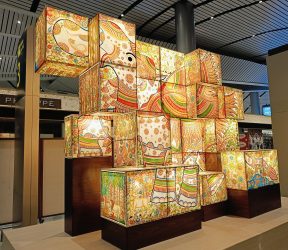

Credit: Hyderabad International Airport
The passenger terminal design integrates traditional art forms such as Cheriyal scrolls, Kalamkari paintings, Etikoppaka wooden toys, and handwoven textiles like Pochampally, Ikat and Gadwal, reflecting the region’s vibrant identity. A dedicated art installation department collaborated closely with architects and curators to bring this vision to life, ensuring authenticity by engaging local artists whose work bridges the traditional and contemporary.
Artists were discovered through social media, online platforms, and visits to local galleries and expos, allowing the team to uncover both renowned and emerging talents. This initiative transformed the terminal into a cultural gallery, where every artwork tells a story, offering travellers a meaningful and memorable connection to the land and its artistic legacy.
The architectural design of the terminal at RGIA, Hyderabad, is a refined reflection of Telangana’s cultural and natural heritage, with the Paala Pitta (Indian Roller), the state bird, serving as a central symbolic motif representing prosperity and vibrancy. A standout feature is the ceiling, which incorporates temple leaf motifs inspired by South Indian temple carvings. These motifs are both decorative and functional, allowing diffused natural light to create a serene, spiritually resonant atmosphere. This sacred geometry extends to signage and wayfinding systems, where the same patterns establish a cohesive visual identity. Additionally, the use of locally sourced materials reinforces the connection to Telangana’s vernacular architecture, supporting regional craftsmanship and sustainability. Altogether, these elements transform the terminal into a cultural gateway that celebrates regional identity while offering travellers a meaningful and immersive experience.
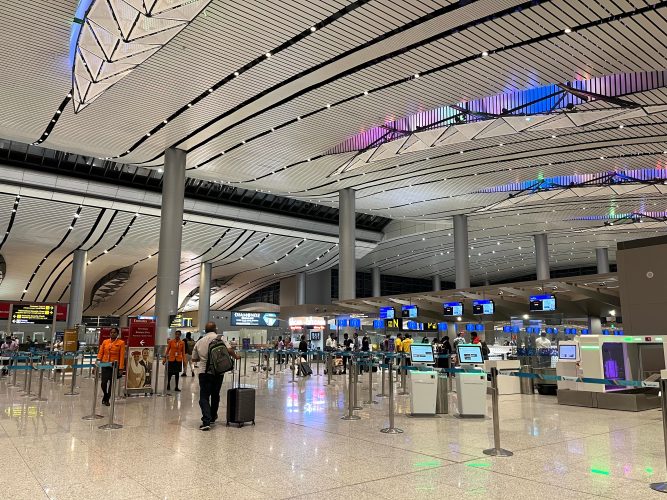

Credit: Hyderabad International Airport
Rajiv Gandhi International Airport (RGIA), serves as a cultural ambassador for Telangana by offering travellers an immersive experience that reflects the region’s rich artistic and architectural heritage. Beyond its role as a transit hub, the airport integrates traditional art forms, such as murals, handcrafted installations and regionally inspired motifs, into its design, creating a strong sense of place. It actively promotes local artists and cultural traditions, showcasing their work throughout the terminal. Seasonal displays and thematic décor celebrating Telangana’s festivals further engage travellers with the region’s cultural rhythms. This thoughtful curation transforms RGIA into a living cultural gallery, offering local passengers a sense of pride and belonging while providing visitors with a memorable introduction to the soul of Telangana.


In addition, RGIA offers a rich array of local food options that celebrate the culinary heritage of Telangana and South India. Travellers can enjoy iconic regional flavours at various outlets for a quick and satisfying meal. These local food offerings are complemented by seasonal menus and thematic presentations during regional festivals, enhancing the cultural experience for travellers.
Madrid-Barajas Airport (MAD), Spain
Madrid Barajas Airport’s Terminal 4, designed by Richard Rogers Partnership and Estudio Lamela, features a kilometre-long undulating roof. The interior is adorned with bamboo panelling, providing warmth and sustainability. Natural light floods the space through skylights, creating a serene environment that reflects Spain’s architectural elegance.
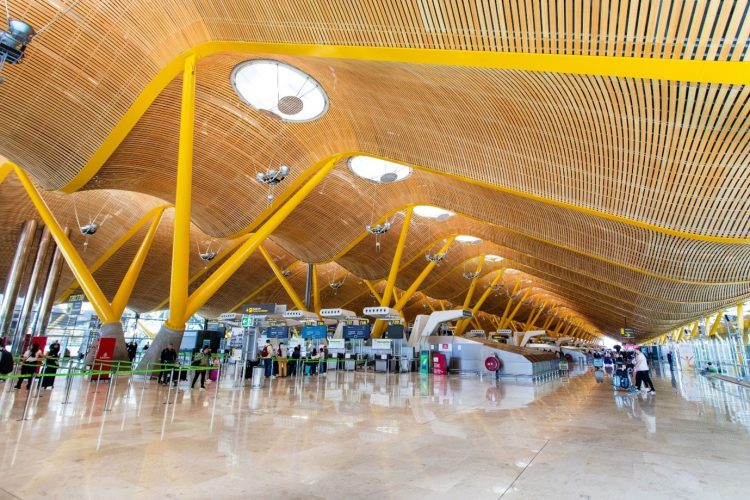

Credit: Aena and Estudio Lamela Arquitectos
In Spain, light has been an important aspect of architecture. It helps illuminate the spaces within the complex and is vital for environmental reasons. However, unlike airports in colder climates, in Madrid, the need to protect the terminal against the harsh heat of the sun is also apparent.
Madrid Airport explains:
“Sun protection all over the building terminal keeps the balance between lighting and energy consumption in an excellent ratio.”
Other important materials are the limestone for flooring and timber for the ceiling. These both create a warm atmosphere in combination with indirect lighting reflectors, avoiding any glare.
The original roof concept retained the original sectional profile from the earliest sketches and repeated the structural distribution across its 1.1 km span, that is the length of the pier. Then the design team decided to undulate the roof in both directions. The result was a sequence of an O-ring surface module, each nine metres.
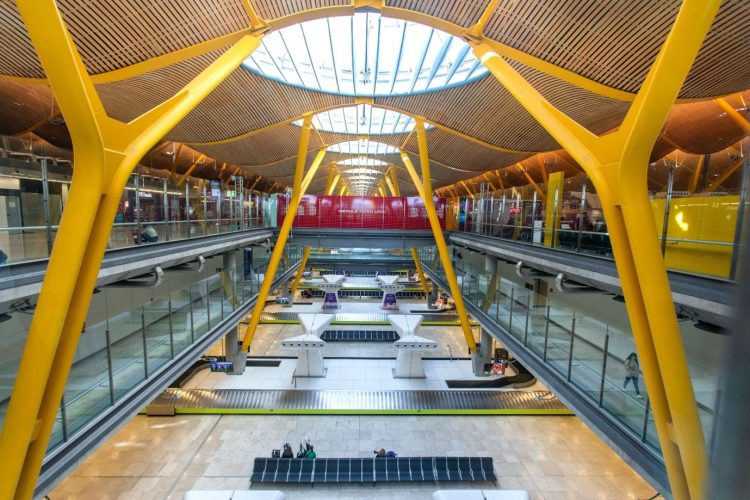

Credit: Aena and Estudio Lamela Arquitectos
Join our free webinar: Revolutionising India’s travel experience through the Digi Yatra biometric programme.
Air travel is booming, and airports worldwide need to move passengers faster and more efficiently. Join the Digi Yatra Foundation and IDEMIA to discover how this groundbreaking initiative has already enabled over 60 million seamless domestic journeys using biometric identity management.
Date: 16 Dec | Time: 09:00 GMT
rEGISTER NOW TO SECURE YOUR SPOT
Can’t attend live? No worries – register to receive the recording post-event.
Related topics
Airport construction and design, Airport development, Equity, Diversity & Inclusion (EDI), Food and Beverage (F&B), Innovation, Passenger experience and seamless travel, Retail, Social responsibility, Sustainability
Related airports
Madrid-Barajas Airport (MAD), Munich International Airport (MUC), Portland International Airport (PDX), Rajiv Gandhi International Airport (HYD), Zurich Airport (ZRH)
Related organisations
AENA, Estudio Lamela, Estudio Lamela Arquitectos, Flughafen Zurich AG, Richard Rogers Partnership




